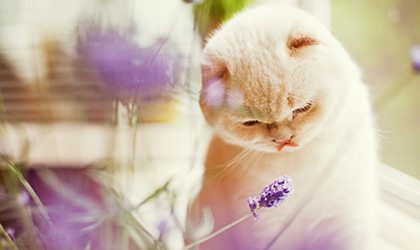
How could you not dote on your feline friends? The way they affectionately knead your lap, tenderly brush against your legs, and gaze at you – oh-so-devotedly – purring their little hearts out. It’s true love. Well, mostly. For there are times when your four-legged friends can seriously rub you up the wrong way too. And rejecting a perfectly clean litter tray, waltzing through the house in true nonchalant fashion at 4 am, and having a full-blown field day with your new curtains are certainly up there as top kitty conundrums. If you’re looking for an explanation for all this feline folly that is, quite frankly, driving you mad, you’ve come to the right place.
Destructive scratching
Has the handy work of your four-legged friend left your sofa in tatters? While you may think your cat only ever commits such crimes to seek ‘revenge’, this simply isn’t true. In reality, Mr Tom’s scratching is normal feline behaviour – an outlet to burn energy, play and mark his territory. He may even do it to remove frayed claws. The good news is that this behaviour is easy to stop with the correct application. And this means you don’t have to settle for bedraggled furniture or prevent kitty from expressing its natural, primitive behaviour. Everyone wins.
Useful tips
-
Buy a scratching post and douse it in catnip to entice your feline friend to use it
-
Keep your kitty’s claws short by trimming them often. This may seem daunting, but it’s much easier than you think. Get your vet to give you a brief tutorial and you will learn this skill for life.
-
Transform your furry friend into a fashionista with a selection of colourful claw caps (a.k.a. nail caps). These teeny tiny vinyl sleeves slip over your cat’s claws and prevent them from doing any damage when they go on a rampage.
Litter box problems
When you’ve gone out of your way to give your feline friend it’s own ‘private bathroom’, there’s nothing worse than discovering little landmines around the house. This complaint comes up trumps for many cat owners. And no wonder. It can be extremely frustrating – not to mention inconvenient and messy (your poor cream carpet). Fur-tunatley, there are many triggers for this behaviour, meaning it shouldn’t be too tricky to resolve.
Useful tips
-
Firstly, it’s always a good idea to consult your vet. Crystals in the urine, bladder stones, and urinary tract diseases are all reasons why your cat may be leaving you such ‘gifts’.
-
Ensure your cat’s litter box is both deep and large enough – ideally, it should be 1.5 x the length of your furry companion
-
Always keep the litter box spick and span – cleaning it once daily usually does the job. If it’s too dirty or foul smelling, your feline may have to watch its step and hold its breath. Can you really blame it for choosing the squeaky-clean kitchen floor instead?
-
Follow this simple rule: one litter box per cat. If your kitties have to wait in line before relieving itself, it may decide to go elsewhere. They’ve got a serious napping schedule to maintain.
-
Some prefer covered boxes, some don’t. Some like scented litter, some don’t. Try test-driving different kinds of litter and boxes to decipher your feline’s ‘thing’.
-
Location, location, location. Keep litter boxes away from loud appliances or areas. The laundry room, for instance, is a big no-no. A sudden crash, bang, wallop! during their peaceful pooping episode may be enough to keep your cat away from that ‘dangerous’ litter box location.
Aggression
While feline aggression is often taken less seriously than aggression in their canine counterparts (perhaps because of their size), aggressive cats can still be challenging. You only have to look at their five potential weapons – all four paws and pin sharp gnashers – to understand they can inflict considerable pain. Cats can become hostile for all sorts of reasons including lack of socialisation, illness, overcrowding, maternal instinct and protection, and even play.
Useful tips
-
A number of medical conditions can trigger aggressiveness in cats, so it’s best to rule out anything serious with your vet first.
-
Unneutered males tend to be the most aggressive of the cat world. As they enter into adulthood, they start challenging other feline foes for access to territory and mates. The solution is pretty simple: neuter your Tomcat.
-
If your cats have the hump, it could be because your household is poorly stocked with all the kitty essentials. Restore some harmony by ensuring you offer enough food, fresh water, litter boxes, toys, perches and beds to reduce competition between cohabiting cats.
-
If you encounter a feline fracas, never pull the fighting cats apart or let them ‘fight it out’. Interrupt the aggression with a squirt of water or loud noise.
-
Queens can become aggressive when defending their young, particularly in the first days after birth. So, where possible, avoid handling kittens when they are teeny tiny bundles of fur.
-
If your cat signals you to stop petting, then you always should. By carefully observing your feline’s body language, you can detect the warning signs: restlessness, a flipping tail, dilated pupils and flattened ears.
-
Reward your furry-friend with praise or treats when they showcase desirable behaviour, such as interacting with another cat in a friendly manner.
-
Play aggression (chasing, attacking, ambushing, pouncing, leaping and biting) can result from cats being left alone for long periods of time without any opportunity to play. It can be exacerbated if their owners encourage them to attack people’s feet and hands. Discourage this behaviour!
Too much night-time activity
Up until their domestication, cats were notorious nocturnal creatures, so complaining about their late-night antics comes as no surprise. But how can you teach your feline friend that night-time is for sleeping – not for playing with your hair, feet or nose?
Useful tips
-
If your furry companion is active and agitated at night, it could signal they’re in pain. Run their nocturnal escapades past your vet to rule out anything serious.
-
Tire out your Tom with an energetic play session before bedtime.
-
Ensure your cat is mentally stimulated during the day, so they’re more inclined to sleep at night. Entertain your feline with plenty of toys, boxes and bags. And make sure they get enough time outside too.
-
Send your cat into a so-called ‘food coma’ by feeding them a big meal before bedtime (cats always nap after eating).
Excessive meowing
Cats meow for a variety of reasons. It’s their primary way of communicating with people – to say hello, to solicit attention, to ask for food, to ask to be let in or out, to find a mate or to notify that something’s wrong. It’s an interesting form of vocalisation in that adult cats don’t meow at each other (except when they are kittens) – rather, just at people. It’s learnt behaviour, really. Meowing gets people to do what they want: simple. Excessive meowing, however, can be frustrating (especially when you aren’t fluent in feline-tongue). To curb your cat’s overzealous meowing, you need to gauge the triggers. You could try these suggestions to control such vocalisations.
Useful tips
-
If your cat meows to greet you, this will be a difficult habit to break. Our best advice is to relish the fact your furry-friend is happy to see you!
-
If the meowing is for attention, teach your cat you’ll pet her once she’s quiet. Resist the urge to give her any form of attention. Wait for a brief moment of silence and then give her the attention she craves. If she meows again, walk away. If you’re consistent, your cat will catch on.
-
If your cat meows for food, fight the urge to feed her when she cries. Instead, feed her at your prescribed times, teaching it’s futile to whine for food outside this window.
-
If your cat meows to be let inside/outside, consider getting a cat flap so you don’t have to play door butler.
-
If your cat is elderly and has just started meowing excessively, make sure you get it evaluated by your vet. This may signal medical conditions, cognitive dysfunction, and sensory deficits.
-
Do not ignore your cat’s meows. It’s safest to assume their cries may indicate something’s wrong – she may not have enough water, access to the litter tray, or could even be locked in a cupboard.
Take home message
Anyone who shares their home with furry felines, knows just how much their pets can rule the roost with their naughtiness and mischief. And while these quirks and oddities do, to a certain extent, make them the loveable creatures they are, this behaviour can be pretty frustrating too. So when things do go awry with your furry companion, take stock of our guidance above and arm yourself with plenty of patience. Oh, and don’t be shy to seek help from professionals too – they’ve seen it all before. With such ingredients to hand, you can bid farewell to dishevelled furniture, litter tray nightmares, and midnight feline parties. Phew.
References:
-
ASPCA. (2018). Common cat behaviour issues. Available online: https://www.aspca.org/pet-care/dog-care/common-dog-behavior-issues
-
Cats Protection. (2018). Cat behaviour problems. Available online: https://www.cats.org.uk/cat-care/cat-behaviour-hub/behaviour-problems
-
RSPCA. (2018). Cat behaviour. Available online: https://www.rspca.org.uk/adviceandwelfare/pets/cats/behaviour
-
McCune, S. (1995). The impact of paternity and early socialization on the development of cat’s behaviour to people and novel objects. Appl Anim Behav Sci., 45:109-124.



